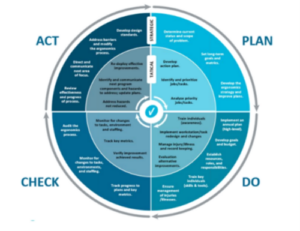
In our recent webinar, VelocityEHS Certified Professional Ergonomist Rick Barker presented a new self-assessment tool to help industries identify the strengths and weaknesses of their current ergonomics program. The presentation reviewed the elements of a successful “Gaps & Fits” process, which follows a continuous improvement model.
There are three main elements you need to understand to get your ergonomics program where it needs to be:
- Current situation – Where is your program now?
- Plans – What do you need to do to reach your goal?
- Goal – Where do you want to be?
What is a Program Self-Assessment?
The “Gaps & Fits” self-assessment tool is based on the elements within ANSI Z10 and ISO 45001. Both use the Plan-Do-Check-Act model, which encourages a continuous improvement process and includes both strategic and tactical items.
A program self-assessment is distinct from an audit tool in that it has the independence of an audit, highlights the importance of evidence, and presents levels within its rating criteria, rather than simple yes or no responses.
Audit is independent of the evaluator, has an importance on evidence, and often has yes or no answers. The program assessment is a self-evaluation that doesn’t require evidence and uses three levels of rating.
There are three evaluation levels:
- Plan content – What are the elements in the plan?
- Process – How does the process (such as hazard identification through control implementation) itself work?
- System – What are the program’s overall strengths and potential gaps?
How do you use the Program Self-Assessment?
Using a 0 – 2 rating scale (0 = Rarely [No], 1 = Sometimes [Partially], 2 = Usually [Yes]), rate the effectiveness of your ergonomics processes by responding to questions about six continuous improvement areas: Policy, Management Review, Plan, Do, Check, and Act. Each area of improvement has seven questions to help highlight gaps within your ergonomics program.
The total of your responses will help you visually identify your program’s strengths and weaknesses. The self-assessment will help you make informed decisions about which areas of improvement to address. For example, even if an area scores low, it may not be effective to address it if it doesn’t fit with your existing work culture. Conducting a thorough gap analysis will allow you to think about and understand why certain areas of improvement scored lower than others.
Overall, it is important to recognize what “fits” and where potential gaps are occurring within your organization’s ergonomics program. Use the program self-assessment tool to learn how to recognize areas of weakness and advance your improvement process.
Session Q&A
Can I use the questions within the self-assessment tool for an audit?
Yes, but if you decide to convert it to an audit, use yes or no answers. Additionally, review each element and add information to the appropriate areas to highlight your company’s policy.
If you have an industrial and an office ergonomics program at different stages, would you complete two separate self-assessments?
Yes. Additionally, if you have multiple facilities, complete one assessment for each. Or if you have one large facility with multiple ergonomics teams, you may find it beneficial to have each team do separate assessments and then compare the results. The self-assessment should not take a substantial amount of time if it’s not being used for auditing purposes.
Do the self-assessment questions cover every aspect of ASNI Z10 and ISO 45001 relating to ergonomics?
No. These questions are the general framework and the most important pieces to have in place.
Say you have an ergonomics program in place, you’re done training, and you have safe behavior, but there is still no standard in place. How do you change the old way of doing the job to a new way of doing it?
Even after adding elements to the self-assessment, there may not be buy-in from the individual stations. The number-one thing to emphasize is front-line worker involvement; are you getting and using their feedback? If not, it may be due to a change management issue or a lack of listening to and communicating with
